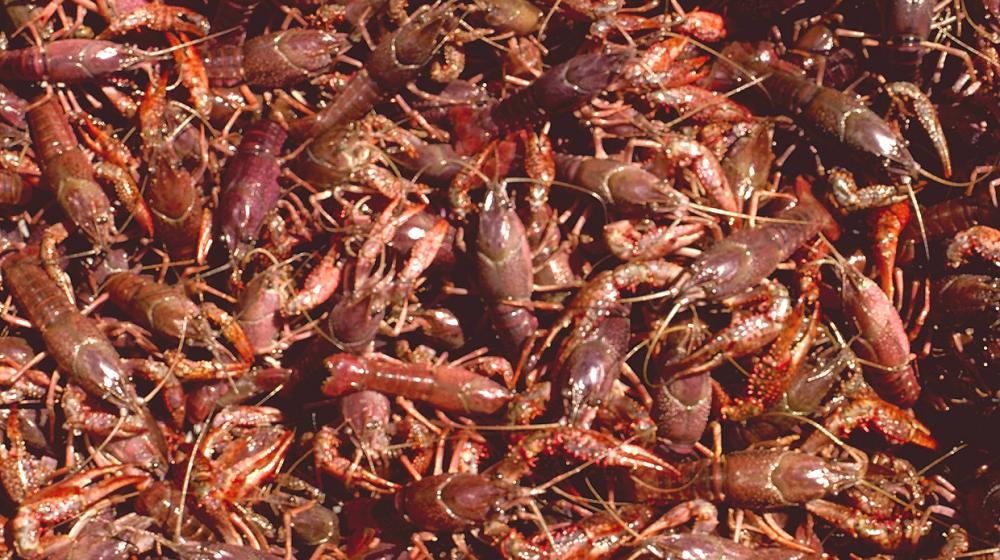Crawfish
The production of red swamp crawfish (Procambarus clarkii) and white river crawfish (Procambarus zonangulus) is feasible because these species are hardy and adaptable. Crawfish production can be integrated with agricultural crop rotations and the crawfish life cycle can be easily manipulated to fit a variety of cultural situations. Crawfish aquaculture relies on control of pond hydrology to simulate optimal wet and dry conditions occurring in natural riverine and wetland habitats. Crawfish grow and mature during the wet or flooded cycle and survive the dry periods by digging burrows. Crawfish ponds are filled in the fall to coincide with peak spawning of females in burrows. When burrows are filled with water, adults and juveniles leave the burrow and distribute themselves.
Production Systems
Crawfish ponds can be single-crop or rotational. Single-crop ponds are in the same location every year with a continuous management scheme. Rotational ponds are those in which crawfish are rotated with other crops. Rotational production also can mean rotating the physical location of the field in which crawfish are grown. Semi-intensive production of crawfish is also possible in deeper ponds with supplemented forage.
Forages
In a natural ecosystem, crawfish eat a variety of plants and animals. Crawfish prefer aquatic invertebrates but will feed on detritus and growing vegetation. Detritus, or decomposing organic material, is the base of the self-sustaining food system required in crawfish culture.
Crawfish production can use planted and cultivated forage crops or voluntary natural vegetation. Cultivated crops are more consistent from year to year and usually provide for a more consistent supply to the underwater food-web. Natural vegetation is usually the least expensive to establish and can sometimes be satisfactory as a forage crop; however, it is often unreliable and insufficient for maximum crawfish production.
Harvest
Unlike fish, crawfish are not harvested by seining. Instead, crawfish are harvested with a passive system that uses baited traps. Harvest begins as early as mid-November and continues through April to June. In well managed ponds, they may be harvested 40 to 90 days per year. Typically, two-thirds of the crop is harvested from March through June when densities of marketable crawfish are highest and crawfish are most active. Trapping is labor intensive and accounts for more than half of the total production expense. Bait and labor are the major costs associated with crawfish production.
Most traps are made of 3/4-inch welded square mesh wire. The square mesh wire is more durable and retains smaller crawfish, thus increasing yield. The “pyramid trap,” with three entrance funnels, has become the industry standard in terms of design. Extensions can be added to increase the height of the trap for use in deeper water. A 6-inch-diameter is placed at the top of the trap as a handle and to prevent crawfish from escaping.
Traps must be baited to attract crawfish. The two types of bait used are natural fish baits and formulated baits. Gizzard shad and Gulf menhaden, or “pogy,” are the most widely used natural baits. Formulated crawfish baits, often referred to as “artificial” or “manufactured” baits contain cereal grains, grain by-products, commercial flavoring agents, and a binder.
Marketing
The supply of live crawfish is highly seasonal, with the peak harvest occurring from March through June. Most producers sell live crawfish to a primary wholesaler or processor, although a few sell directly to retail stores, restaurants, and consumers. Live crawfish are not stored and transported in water, but in plastic mesh sacks that hold 35 to 40 pounds of crawfish.
Prices are highest in winter and early spring when supply is relatively low, and they decline significantly in late spring and summer when supply peaks. In Louisiana, the price for ungraded crawfish may decline as much as 40 to 55 percent for several weeks during peak production. The wholesale price of a pound of tail meat is usually about ten to twelve times higher than the wholesale price of a pound of live crawfish.
Mississippi
Crawfish production in Mississippi, although commercially feasible, has not been a strong industry. There are very few acres devoted to commercial production in the state, while Louisiana, for example has over 100,000 acres. The proximity to the Louisiana production area is one reason that crawfish farming has not blossomed in Mississippi. Other reasons include the apparent competition with a large catfish industry, somewhat higher production costs in the state, and lack of cultural impetus such as exists in Louisiana.
MSU Publications
Other Crawfish Information
Procambarid Crawfish: Life History and Biology
Crawfish Production: Financial Characteristics and Record-Keeping Options
Crawfish Production: Pond Construction and Water Requirements
Crawfish Production: Production Systems and Forages
Crawfish Production: Harvesting
Crawfish Trap Design and Construction
Crawfish Aquaculture – Marketing


